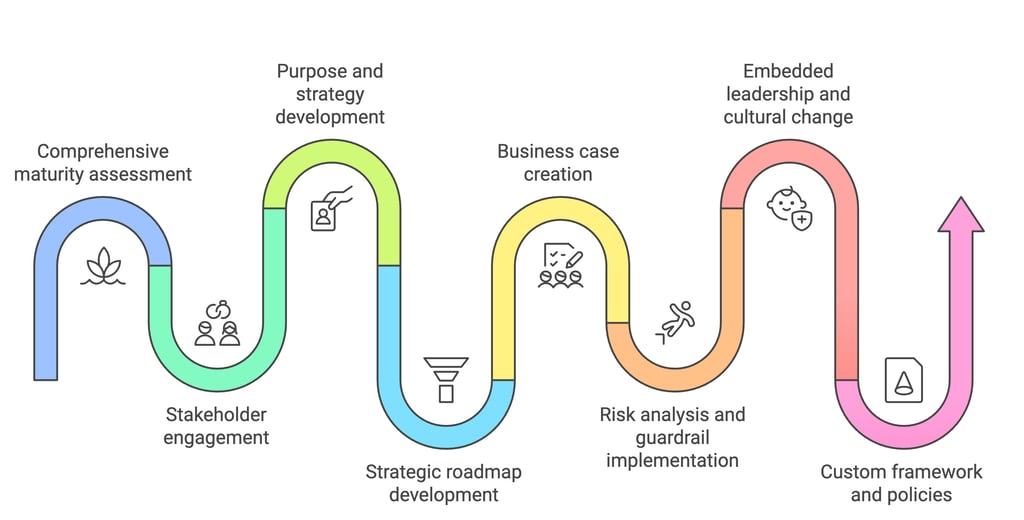Data protection purpose and strategy
A comprehensive framework for building trust, driving growth, and ensuring ethical data practices
These days, data protection is no longer just a legal requirement – it's a strategic imperative. Our comprehensive framework provides companies with the knowledge, tools, and guidance to cultivate a clear data protection purpose and implement a robust strategy that aligns with business objectives, builds trust with stakeholders, and enables sustainable growth. Moving beyond a purely legal perspective, this framework transforms data protection from a "necessary evil" into a business growth enabler and a source of competitive advantage.
Key Benefits:
Elevate Data Protection to a Strategic Level: Integrate data protection into your company's core business strategy, ensuring that it's not just an afterthought but a fundamental consideration in all personal data related decision-making processes.
Build and Maintain Stakeholder Trust: Demonstrate a genuine commitment to data protection, building trust with employees, customers, partners, and other stakeholders. Address the concerns that keep your CEO awake at night – not just regulatory fines, but the erosion of customer trust and reputational damage.
Drive Business Growth and Innovation: Unlock the potential of personal data while ensuring ethical and responsible data use, enabling innovation and creating new business opportunities. Use data protection as a competitive differentiator, attracting and retaining customers who value trust and transparency.
Proactively Manage Data Protection Risks: Identify and mitigate key data protection risks, going beyond generic compliance to address the real-world impact on individuals. Implement reporting mechanisms that align data protection metrics with business needs to have insight on how to manage daily operations and drive business value.
Improve Stakeholder Engagement and Collaboration: Engage key stakeholders across the company, including senior management, digital marketing, HR, IT, and legal, by communicating the value of data protection in their terms and building a shared sense of responsibility.
Create a Sustainable Data Protection Programme: Develop a practical, actionable framework that integrates seamlessly into your company's daily operations. Through adequate investment, implement effective policies, tailored procedures, and meaningful metrics. Move beyond generic risk assessments and implement a concrete maturity assessment that can be used to improve any existing data protection programme.
Staying Ahead: By incorporating foresight and horizon scanning into your work you be able to proactively monitor all the ever-evolving regulations and emerging technologies.
Adapt to Emerging Technologies: Address the unique challenges and opportunities presented by emerging technologies like AI, ensuring that data protection is built in from the start.
Integrate with ESG and Social Responsibility: Align data protection initiatives with broader ESG (Environmental, Social, and Governance) and CSR (Corporate Social Responsibility) objectives, demonstrating a commitment to ethical and sustainable business practices.


Key Features:
The "Why": Define the key elements of a data protection strategy. Understand the key triggers that make data protection purpose and strategy essential, including the limitations of relying solely on enforcement and the critical role of trust in today's marketplace.
The "What": Define the key work packages involved in the formulation of your data protection strategy, including gap analysis, alignment with business objectives, consideration of unique organisational factors, and the identification of key enablers across various domains (policies, procedures, behaviour, competencies, governance, technology, accountability).
The "How": Follow a step-by-step guide to cultivating a data protection purpose and implementing a strategy, including stakeholder engagement, maturity assessments, prioritisation, and the development of a detailed roadmap.
Key Deliverables: Utilise the key deliverables of a data protection strategy, including easy to follow one-pagers, detailed plans, an outcomes roadmap focused on business impact, and actionable insights for improving your data protection posture.
The Importance of Purpose: Embrace the need for a clear and compelling "data protection purpose" that resonates with leadership and employees, moving beyond compliance to a value-driven approach that promotes ethical data practices and builds trust.
Target Audience:
This framework approach can easily be applied to other disciplines aside from data protection, for example AI Governance, Information or Cyber Security, to name a couple. Here is a list of roles that could benefit from applying our framework:
Data protection leaders
Privacy officers
Compliance Officers
Chief Information Security Officers (CISOs)
Chief Marketing Officers (CMOs)
Chief Information Officers (CIOs)
Chief Technology Officers (CTOs)
Risk Officers
Senior management
Anyone involved in data processing and risk management
Value Proposition:
This Data Protection Purpose and Strategy Framework provides a roadmap for organisations to transform their approach to data protection, moving from a reactive, compliance-driven mindset to a proactive, value-driven approach. By aligning data protection with business objectives, building trust with stakeholders, and fostering a culture of ethical data practices, companies can unlock the full potential of data while mitigating risks and achieving sustainable growth. This framework is not just about avoiding fines – it's about building a better business.
Interested?
Let’s transform how your organisation views data protection. Feel free to get in touch to arrange a no obligation call to discuss your current situation and challenges with a view to making tangible improvements.
Purpose and Means
Purpose and Means believes the business world is better when companies establish trust through impeccable governance.
BaseD in Copenhagen, OPerating Globally
tc@purposeandmeans.io
+45 6113 6106
© 2025. All rights reserved.
